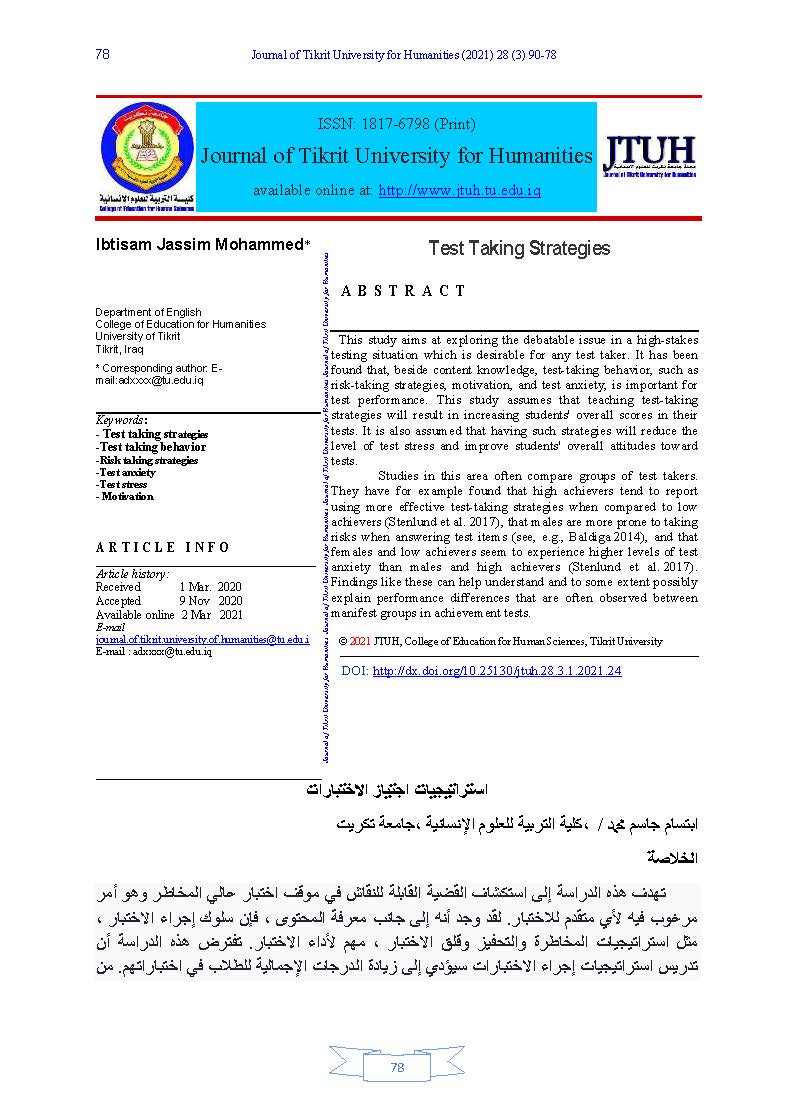Test Taking Strategies
Main Article Content
Abstract
This study aims at exploring the debatable issue in a high-stakes testing situation which is desirable for any test taker. It has been found that, beside content knowledge, test-taking behavior, such as risk-taking strategies, motivation, and test anxiety, is important for test performance. This study assumes that teaching test-taking strategies will result in increasing students' overall scores in their tests. It is also assumed that having such strategies will reduce the level of test stress and improve students' overall attitudes toward tests.
Studies in this area often compare groups of test takers. They have for example found that high achievers tend to report using more effective test-taking strategies when compared to low achievers (Stenlund et al. 2017), that males are more prone to taking risks when answering test items (see, e.g., Baldiga 2014), and that females and low achievers seem to experience higher levels of test anxiety than males and high achievers (Stenlund et al. 2017). Findings like these can help understand and to some extent possibly explain performance differences that are often observed between manifest groups in achievement tests.
Metrics
Article Details

This work is licensed under a Creative Commons Attribution 4.0 International License.
College of Education for Humanities, TIKRIT UNIVERSITY. THIS IS AN OPEN ACCESS ARTICLE UNDER THE CC BY LICENSE http://creativecommons.org/licenses/by/4.0/
References
Al Fraidan, A., & Al-Khalaf, K. (2012). Test-taking strategies of Arab EFL learners on multiple choice tests. International Education Studies, 5(4), 80-85.
Baldiga, K. (2014). Gender differences in willingness to guess. Manag Sci, 60(2), 434–448.
Bicak, B. (2013). Scale for test preparation and test taking strategies. Educational Science: Theory and Practice, 13(1), 279–289.
Bremmer, S. (1999). Language learning strategies and language proficiency: investigating the relationship in Hong Kong. The Canadian Modern Language Review, 55, 496-514.
Brodsky, M. (2004). Preparing for tests. Retrieved from www.mth.msu.edu/mccarthy/student.information/testprep.html
Casbarro, J. (2005). Test anxiety & what you can do about it. In A Practical Guide for Teachers, Parents, and Kids. U.S.A: National Professional Resources.
Chargar, E. (2002). Test anxiety. Retrieved from http:// www.umr.edu/~cousel/test.
Cohen, A. D. (2000). Strategies in Language and Using a Second Language. Beijing: Foreign Language Teaching and Research Press.
Cohen, A. D., & Upton, T. A. (2006). Strategies in responding to the new TOEFL reading tasks (ETS Research Report No. RR-06-06). Princeton, N.J: Educational Testing Service.
Coombe, C., & N. Hubley. (1988). Empowering students in test-taking strategies. Paper presented at TESOL Arabia Conference, Alin, UAE.
Deanna, L. N. (2002). Language learning strategies and English proficiency of Chinese University students. Regent University: Unpublished Ph.D. dissertation.
Dodeen, H. M., Abdelfattah, F., & Alshumrani, S. (2014). Test-taking skills of secondary students: The relationship with motivation, attitudes, anxiety and attitudes towards tests. South African Journal of Education, 34(2), 1–18.
Fieber, S. (2001). Test anxiety. Retrieved from http:// www. Counseling.uci.
Jimenez, R. T., Garcia, G. E., & Pearson, D. P. (1996). The reading strategies of bilingual Latin students who are successful English readers: opportunities and obstacles. Reading Research Quarterly, 31, 90-112
Krivoshik, L. (2003). Taking Essays Tests. Retrieved from
Lane, P. (2001, August 31). How to take tests? A three-step approach. Khaleej Times Weekend, p.6.
Liu, O. (2004). Investigating the relationship between test preparation and TOEFL iBT performance. Retrieved from Educational Testing Service: http://onlinelibrary.wiley.com/doi/10.1002/ets2.12016/epdf
Loulou, D. (1995). Making the A: How to study for tests. ERIC / AE Digest Series. Retrieved from http://www.campus.cua.edu/www/eric_ae/digests/tm9510.htm
Milnamow, K. (2001). Relieving Test Anxiety. Retrieved from
Peng, Y. 2005. Test preparation strategies and test taking strategies use in Chinese high school students (Unpublished doctoral dissertation), University of Nevada, Las Vegas, USA.
Phakiti, A. (2003). A closer look at the relationship of cognitive and metacognitive strategy use to EFL reading achievement test performance. Language Testing, 20(1), 26-56.
Stenlund, T., Eklöf, H., & Lyrén, P.-E. (2017). Group differences in test-taking behavior: An example from a high-stakes testing program. Assessment in Education: Principles, Policy & Practice, 24(1), 4–20. doi: 10.1080/0969594X.2016.1142935.
Sweetnam, K.R. (2002). Test taking strategies and student achievement. Cloquet, Minnesota, USA: Running Head.
VanZile-Tamsen, C., & Livingston, J. A. (1999). The differential impact of motivation on the self-regulated strategy use of high- and low-achieving college students. Journal of College Student Development, 40, 54–60. www.uic.edu/depts/counseletr/ace/testanxiety.htm
Winke, P., & Lim, H. (2017). The effects of test preparation on second-language listening test performance. Language Assessment Quarterly, 14, 380–397. doi:10.1080/15434303.2017.1399396
Young, C. (2003). Preparing for Tests. Retrieved from http: www.sunynassau.edu/dptpages/ashs/lab/Study.html




